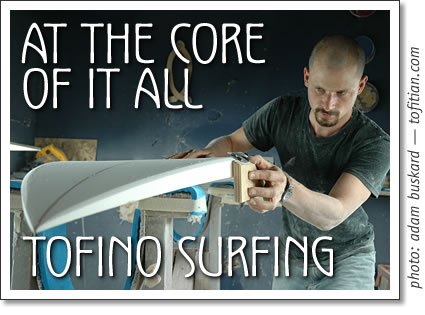
At the Core of it All - Surfboards from Tofino
by Stefan Aftanas, Tofino
 There isn’t a lot to the old faithful “poly” surfboard. There is a polyurethane foam core sandwiched between a few layers of woven fibreglass cloth and saturated with a thermo-set polyester resin. As a reductionist, I find it simply beautiful. But what about that foam core? How is it made?
There isn’t a lot to the old faithful “poly” surfboard. There is a polyurethane foam core sandwiched between a few layers of woven fibreglass cloth and saturated with a thermo-set polyester resin. As a reductionist, I find it simply beautiful. But what about that foam core? How is it made?
Without turning this into a chemistry lesson, polyurethane foam is born when a monomer and hydroxyl are combined. In the case of surfboard blanks, these two chemicals are liquids that are mixed together and poured or injected into moulds. The mould is clamped or held shut by hydraulic arms and a chemical reaction ensues.
The result is a rigid piece of foam known as a blank. Although this seems simple enough, “blowing” foam with consistent densities is extremely difficult and has brought many a person to their financial end.
After the blank is blown, it is removed from the mould, marked with its mould name, its density, the initials of the person who created it, the rocker to be glued into it and the name of the customer who ordered it. The blank is then sawn in half and a stinger, painted with polyurethane glue, is inserted between the two halves. The blank is clamped back together, sandwiching the newly-inserted stinger, and then left to cure. The purpose of adding a stinger is to hold “rocker” in the blank. The blank itself has some rocker from the moulding process but the addition of the stringer is an opportunity to adjust the rocker to the customer’s preferences and fix that rocker permanently into the blank.
The density and ultimately the weight of a blank are controlled through the amount of liquid poured into the mould before it is clamped closed. More liquid produces more foam. Since the expansion of the foam is contained by the mould, a higher-density blank is achieved. Of course the converse is true with less liquid producing a lower-density blank. Higher-density blanks are heavier but more resilient to collapsing while lower-density blanks are lighter and can be prone to collapsing. To add to the fun, densities are not equal throughout the thickness of a blank. Density decreases rapidly about ¼ʺ from the surface. With this in mind, you can have a board that tends to collapse even though a high-density foam was used.
Even with just a cursory review of how a blank is created, one can get an understanding of the importance of choosing the right blank for the intended board. To make life easy, the blank should be reasonably close in length and width. To avoid distortion, rockers should be built into the blank rather than shaped into it. Even the best hand-shapers in the world are reluctant to make radical changes to rocker. Thickness is important since as we know the deeper you cut into a blank, the softer and less-dense the foam gets. Cutting into the softer core or “over shaping” can cause all sorts of problems, not the least of which is a board with a very short lifespan.
All too often the early demise of a surfboard is blamed on the glass job when in reality, poor choice in blank selection was likely at the core of it all.
Stefan Aftanas is the owner and lead shaper of Atanas Surfboards in Tofino. Visit his website at www.aftanasdesigns.com
Tofino Time September 2012
- September 2012 in Tofino
- Tofino events: September 2012
- Tofino concerts: September 2012
- Tofino movies in September 2012
- Surfboards from Tofino: At the Core of it All
- Ucluelet Aquarium: Gulp of Seawater
- The Floating Gardens at Freedom Cove
- Tofino tide table for September 2012
- Tofino surf reports for September 2012
- Community Directory: Goods & Services in Tofino
tofino | tofino time | activities | accommodation | events | directory
maps | travel | food | art & artists | photos | horoscope | tides
search | magazine | issues | articles | advertising | contact us
hosted in tofino by tofino.net & studio tofino
© 2002-2014 copyright Tofino Time Magazine in Tofino Canada
Tofino surfboard shaper Stefan Aftanas wrote this primer on surf boards for Tofino Time Magazine in September 2012.

quick links:
- tofino accomodations
- tofino calendar
- tofino surf report
- tofino horoscope
- march horoscope
- tofino map
- tofino fishing report
- tofino tides
- tofino weddings
tofino events:
- tofino concerts
- tofino events
- tofino movies
- tofino festivals
- tofino yoga classes
- tofino whale festival
tofino time magazine:
- tofino time march 2016
- tofino event listings march 2016
- tofino concerts in march 2016
- tofino movies in march 2016
- cox bay | wickaninnish beach
- chesterman beach
- tonquin beach
- tofino brewing co.
- tofino wedding guide
tofino accommodation:
- tofino cabin
- tofino camping
- bed & breakfasts in Tofino
- tofino hostels
- tofino motels
- tofino hotels
- tofino vacation rentals
- petfriendly accommodation
activities:
- tofino bike rentals
- tofino bear watching
- tofino bird watching
- tofino boat charters & cruises
- tofino fishing
- hot springs cove
- sea kayaking in tofino
- tofino storm watching
- tofino surfing
- tofino whale watching
- tofino yoga
shopping:
services:
- tofino yoga, spa & wellness
- tofino restaurants
- tofino internet cafes
- tofino travel & transportation
- tofino real estate
- tofino taxi services
- tofino wedding & events
